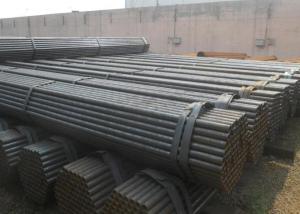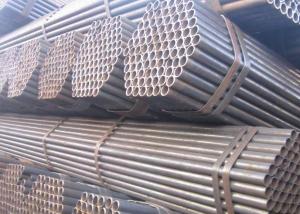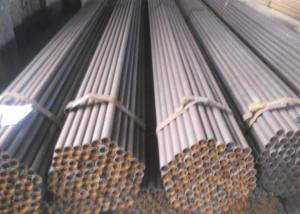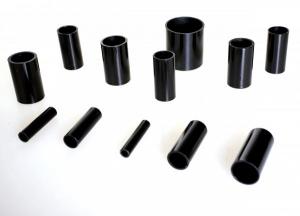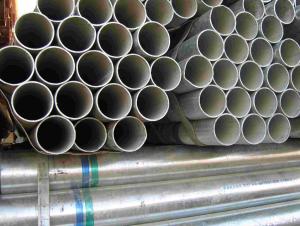High Quality ERW Welded Steel Pipes
- Loading Port:
- China Main Port
- Payment Terms:
- TT or L/C
- Min Order Qty:
- 50MT m.t.
- Supply Capability:
- based on order m.t./month
OKorder Service Pledge
OKorder Financial Service
You Might Also Like
ERW Welded Steel Pipes
Application of High Quality ERW Welded Steel Pipes
It is widely applied to line pipe and casing and tubing in oil transportation and casing field, and it is used in Low,high pressure liquid and gassy transportation and it is also good Structure pipe (for furniture, window, door, building , bridge, mechanical etc).
Package: bundles with anti-rust painting and with plastic caps
Standard of High Quality ERW Welded Steel Pipes
API SPEC 5L, API SPEC 5CT, ASTM A53, GB/T9711.1
Steel Grade of High Quality ERW Welded Steel Pipes
API SPEC 5L: B, X42, X46, X52, X56, X60, X65
API SPEC 5CT: J55, K55, N80, L80-1
ASTM A53: A, B, C
GB/T9711.1:L242、L290、L320、L360、L390、L415、L450
Sizes of pipes of High Quality ERW Welded Steel Pipes
*Remark: Besides below sizes, we also can arrange production based on requirement of customers
OD | WT | WEIGHT | ||||
INCH | MM | SCH | MM | INCH | KG/M | LB/INCH |
1 1/2” | 48.3 | STD-40 | 3.68 | 0.145 | 4.09 | 2.75 |
1 1/2” | 48.3 | XS-80 | 5.08 | 0.2 | 5.47 | 3.68 |
2” | 60.3 | STD-40 | 3.91 | 0.154 | 5.49 | 3.69 |
2” | 60.3 | XS-80 | 5.54 | 0.218 | 7.56 | 5.08 |
2 1/2” | 73 | STD-40 | 5.16 | 0.203 | 8.72 | 5.86 |
2 1/2” | 73 | XS-80 | 7.01 | 0.276 | 11.52 | 7.74 |
3” | 88.9 | STD-40 | 5.49 | 0.216 | 11.41 | 7.67 |
3” | 88.9 | XS-80 | 7.62 | 0.3 | 15.43 | 10.37 |
3 1/2” | 101.6 | STD-40 | 5.74 | 0.226 | 13.71 | 9.21 |
3 1/2” | 101.6 | XS-80 | 8.08 | 0.318 | 18.83 | 12.65 |
4” | 114.3 | STD-40 | 6.02 | 0.237 | 16.24 | 10.91 |
4” | 114.3 | XS-80 | 8.56 | 0.337 | 22.55 | 15.15 |
5” | 141.3 | STD-40 | 6.55 | 0.258 | 21.99 | 14.78 |
5” | 141.3 | XS-80 | 9.53 | 0.375 | 31.28 | 21.02 |
6” | 168.3 | STD-40 | 7.11 | 0.28 | 28.55 | 19.19 |
6” | 168.3 | XS-80 | 10.97 | 0.432 | 42.99 | 28.89 |
8” | 219.1 | STD-40 | 8.18 | 0.322 | 42.98 | 28.88 |
8” | 219.1 | XS-80 | 12.7 | 0.5 | 65.3 | 43.88 |
10” | 273 | STD-40 | 9.27 | 0.365 | 60.9 | 40.92 |
10” | 273 | 80 | 15.09 | 0.594 | 96.95 | 65.15 |
12” | 323.8 | STD | 9.53 | 0.375 | 74.61 | 50.13 |
12” | 323.8 | 40 | 10.31 | 0.406 | 80.51 | 54.1 |
12” | 323.8 | XS | 12.7 | 0.5 | 98.42 | 66.14 |
12” | 323.8 | 80 | 17.48 | 0.688 | 133.38 | 89.63 |
14” | 355.6 | 40 | 11.13 | 0.438 | 95.51 | 64.18 |
14” | 355.6 | XS | 12.7 | 0.5 | 108.48 | 72.9 |
14” | 355.6 | 80 | 19.05 | 0.75 | 159.71 | 107.32 |
16” | 406.4 | XS-40 | 12.7 | 0.5 | 124.55 | 83.69 |
18” | 457 | STD | 9.53 | 0.375 | 106.23 | 71.38 |
18” | 457 | 40 | 14.27 | 0.562 | 157.38 | 105.75 |
18” | 457 | 80 | 23.83 | 0.938 | 257.13 | 172.78 |
20” | 508 | 40 | 15.09 | 0.594 | 185.28 | 124.5 |
20” | 508 | 80 | 26.19 | 1.031 | 314.33 | 211.22 |
Standard: API SPEC 5L
Mechanical Properties of High Quality ERW Welded Steel Pipes
Standard | Grade | (MPa) | (MPa) | |||
Yield strength | Tensile Strength | |||||
API SPEC 5L | PSL1 | |||||
B | ≥241 | ≥414 | ||||
×42 | ≥290 | ≥414 | ||||
×46 | ≥317 | ≥434 | ||||
×52 | ≥359 | ≥455 | ||||
×56 | ≥386 | ≥490 | ||||
×60 | ≥414 | ≥517 | ||||
×65 | ≥448 | ≥531 | ||||
×70 | ≥483 | ≥565 | ||||
PSL2 | ||||||
| Min | Max | Min | Max | ||
B | 241 | 448 | 441 | 758 | ||
×42 | 290 | 496 | 414 | 758 | ||
×46 | 317 | 524 | 434 | 758 | ||
×52 | 359 | 531 | 455 | 758 | ||
×56 | 386 | 544 | 490 | 758 | ||
×60 | 414 | 565 | 517 | 758 | ||
×65 | 448 | 600 | 531 | 758 | ||
×70 | 483 | 621 | 565 | 758 | ||
Chemical Composition (%) of High Quality ERW Welded Steel Pipes
Standard | Grade | C | Mn | P | S | TI | CEV |
Max | Max | Max | Max | Max | Max | ||
API SPEC 5L | PSL1 | ||||||
B | 0.26 | 1.2 | 0.030 | 0.030 | 0.04 |
- | |
×42 | 0.26 | 1.3 | 0.030 | 0.030 | 0.04 | ||
×46,×52,×56,X60 | 0.26 | 1.4 | 0.030 | 0.030 | 0.04 | ||
X65 | 0.26 | 1.45 | 0.030 | 0.030 | 0.06 | ||
X70 | 0.26 | 1.65 | 0.030 | 0.030 | 0.06 | ||
PSL2 | |||||||
B | 0.22 | 1.20 | 0.025 | 0.015 | 0.04 |
0.43 | |
×42 | 0.22 | 1.30 | 0.025 | 0.015 | 0.04 | ||
×46,×52,×56, X60 | 0.22 | 1.40 | 0.025 | 0.015 | 0.04 | ||
X65 | 0.22 | 1.45 | 0.025 | 0.015 | 0.06 | ||
X70 | 0.22 | 1.65 | 0.025 | 0.015 | 0.06 | ||
Standard: GB/9711.1
Mechanical Properties of High Quality ERW Welded Steel Pipes
Standard | Grade | (MPa) | (MPa) | Min(%) |
Yield strength | Tensile Strength | Elongation | ||
GB/T9711.1 | L245 | ≥245 | ≥415 | 21 |
L290 | ≥290 | ≥415 | 21 | |
L320 | ≥320 | ≥435 | 20 | |
L360 | ≥360 | ≥460 | 19 | |
L390 | ≥390 | ≥490 | 18 | |
L415 | ≥415 | ≥520 | 17 | |
L450 | ≥450 | ≥535 | 17 | |
L485 | ≥485 | ≥570 | 17 |
Chemical Composition(%) of High Quality ERW Welded Steel Pipes
Standard | Grade | C | Mn | P | S |
Max | Max | Max | Max | ||
GB/T9711.1 | L245 | 0.26 | 0.15 | 0.030 | 0.030 |
L290 | 0.28 | 1.25 | 0.030 | 0.030 | |
L320, L360 | 0.30 | 1.25 | 0.030 | 0.030 | |
L390, L415 | 0.26 | 1.35 | 0.030 | 0.030 | |
L450 | 0.26 | 1.40 | 0.030 | 0.030 | |
L485 | 0.23 | 1.60 | 0.025 | 0.030 |
Standard: GB/9711.2
Mechanical Properties of High Quality ERW Welded Steel Pipes
Standard | Grade | (MPa) Yield strength | (MPa) Tensile Strength | Min(%) Elongation | ||
GB/T9711.2 | Rt0.5Min | Rt0.5Max | RmMin | Rt0.5/Rm Max | ||
L245 |
245 |
440 | 0.80 |
22 | ||
L245 | 0.85 | |||||
L290 |
290 |
440 | 0.80 | 21 | ||
L290 | 0.85 | |||||
L360 |
360 |
510 | 0.85 |
20 | ||
L360 | 0.85 | |||||
L415 |
415 |
565 | 0.85 |
18 | ||
L415 | 0.85 | |||||
L450 | 450 | 570 | 535 | 0.87 | 18 | |
L485 | 485 | 605 | 570 | 0.90 | 18 | |
Chemical Composition (%) of High Quality ERW Welded Steel Pipes
Standard | Grade | C | Mn | P | S | V | Nb | Ti | CEV |
Max | Max | Max | Max | Max | Max | Max | Max | ||
GB/T9711.2 | L245NB | 0.16 | 1.1 | 0.025 | 0.020 | - | - | - | 0.42 |
L290NB | 0.17 | 1.2 | 0.025 | 0.020 | 0.05 | 0.05 | 0.04 | 0.42 | |
L360NB | 0.20 | 1.6 | 0.025 | 0.020 | 0.10 | 0.05 | 0.04 | 0.45 | |
L415NB | 0.21 | 1.6 | 0.025 | 0.020 | 0.15 | 0.05 | 0.04 | - | |
L245NB, L290NB |
0.16 |
1.5 | 0.025 | 0.020 |
0.04 |
0.04 |
- |
0.4 | |
L360NB | 0.16 | 1.6 | 0.025 | 0.020 | 0.05 | 0.05 | 0.04 | 0.41 | |
L415NB | 0.16 | 1.6 | 0.025 | 0.020 | 0.08 | 0.05 | 0.06 | 0.42 | |
L450NB | 0.16 | 1.6 | 0.025 | 0.020 | 0.10 | 0.05 | 0.06 | 0.43 | |
L485NB | 0.16 | 1.7 | 0.025 | 0.020 | 0.10 | 0.06 | 0.06 | 0.43 |
Standard: ASTM A53
Mechanical Properties of High Quality ERW Welded Steel Pipes
Standard | Grade | (MPa) | (MPa) |
Yield strength | Tensile Strength | ||
ASTM A53M | A | 205 | 330 |
B | 240 | 415 |
Chemical Composition(%) of High Quality ERW Welded Steel Pipes
Standard | Grade | C | Mn | P | S | V | Ni | Cu | Cr | Mo |
Max | Max | Max | Max | Max | Max | Max | Max | Max | ||
ASTM A53M | A | 0.25 | 0.95 | 0.05 | 0.045 | 0.08 | 0.4 | 0.5 | 0.4 | 0.15 |
B | 0.30 | 1.20 | 0.05 | 0.045 | 0.08 | 0.4 | 0.5 | 0.4 | 0.15 |

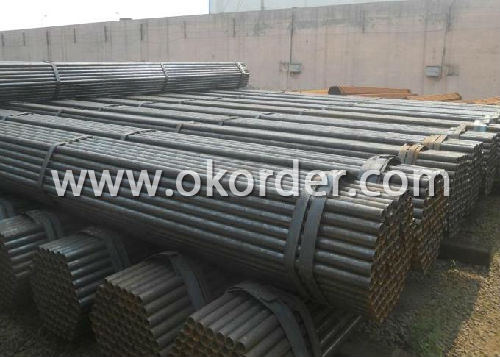
- Q:How are steel pipes coated for aesthetic purposes?
- Steel pipes can be coated for aesthetic purposes in several ways. One common method is through the application of a powder coating. Powder coating involves spraying a dry powder onto the surface of the steel pipe and then heating it to create a durable and attractive finish. This process allows for a wide range of color options and provides a smooth, even coating. Another method used for aesthetic coating is electroplating. Electroplating involves immersing the steel pipe in a solution containing metal ions, such as chrome or zinc, and passing an electric current through it. This causes the metal ions to bond with the surface of the pipe, creating a thin, decorative layer. Electroplating can produce a variety of finishes, including shiny, reflective surfaces or more matte, textured appearances. Painting is also a common method for coating steel pipes for aesthetic purposes. This involves applying a liquid paint or enamel to the surface of the pipe. By choosing different colors, textures, and finishes, painting allows for a wide range of aesthetic possibilities. However, it is important to ensure that the paint used is specifically formulated to adhere to metal surfaces and withstand the environmental conditions the pipe will be exposed to. In addition to these methods, steel pipes can also be coated using techniques such as hot-dip galvanizing or metal cladding. These processes involve the application of a layer of another metal, such as zinc or aluminum, to the surface of the steel pipe. This not only enhances the appearance of the pipe but also provides protection against corrosion, extending its lifespan. Overall, there are multiple methods available for coating steel pipes for aesthetic purposes. Each method offers its own advantages and can be chosen based on the desired appearance, durability, and environmental conditions. It is important to consider factors such as color, texture, finish, and protective properties when selecting the coating method to ensure the desired aesthetic result is achieved.
- Q:What are the factors to consider when selecting steel pipes?
- Some factors to consider when selecting steel pipes include the intended application and environment, the required strength and durability, the size and thickness of the pipes, the corrosion resistance, the cost, and the availability of different types of steel pipes.
- Q:How are steel pipes used in the construction of solar power plants?
- Steel pipes are commonly used in the construction of solar power plants to support the installation of solar panels and to carry the flow of fluids, such as water or steam, within the plant. They provide structural integrity and durability necessary to withstand the environmental conditions and weight of the solar panels. Additionally, steel pipes are used for the installation of underground transmission lines, ensuring efficient and reliable electricity distribution from the solar power plant to the grid.
- Q:How are steel pipes used in transportation?
- Steel pipes are commonly used in transportation for various purposes. They are used in the construction of pipelines for transporting fluids, such as oil, gas, and water, over long distances. Steel pipes are also utilized in the manufacturing of vehicle components, including exhaust systems, chassis, and suspension parts. Additionally, steel pipes can be found in infrastructure projects like bridges and tunnels, providing structural support for transportation networks.
- Q:How do you determine the pipe schedule for steel pipes?
- Several factors, including pressure rating, wall thickness, and outer diameter, are taken into account to determine the pipe schedule for steel pipes. The pipe schedule serves as a standardized system that classifies the thickness of pipe walls, ensuring compatibility and safety in various applications. To ascertain the pipe schedule for steel pipes, one must consider the maximum pressure the pipe will endure, typically measured in pounds per square inch (psi) or bars. The pressure rating indicates the pipe's ability to withstand pressure without experiencing failure or leakage. Higher pressure ratings necessitate thicker pipe walls. Another crucial factor in determining the pipe schedule is the wall thickness, typically expressed in inches or millimeters. The wall thickness directly correlates with the pressure rating, as thicker walls have the capacity to handle higher pressures. The American National Standards Institute (ANSI) has established a set of standardized wall thicknesses for steel pipes known as the "pipe schedule." The outer diameter of the pipe is also taken into consideration when determining the pipe schedule. The specific application and requirements influence the outer diameter variation. Selecting a pipe with the appropriate outer diameter is essential to ensure proper fit and compatibility with fittings, valves, and other components. In conclusion, the pipe schedule for steel pipes is determined by examining the maximum pressure, wall thickness, and outer diameter. By aligning these factors with the suitable pipe schedule, one can guarantee that the steel pipe is appropriate for its intended usage and capable of withstanding the required pressure.
- Q:Are steel pipes suitable for underground installations?
- Yes, steel pipes are suitable for underground installations. Steel pipes are known for their durability, strength, and resistance to corrosion, making them ideal for underground use. They can withstand the pressure from the surrounding soil and are able to handle heavy loads, making them a reliable choice for underground installations such as drainage systems, water supply lines, and underground utilities.
- Q:What is the impact of temperature on steel pipes?
- The significance of temperature on steel pipes cannot be underestimated, as it can bring about both positive and negative consequences. When exposed to high temperatures, steel pipes undergo thermal expansion, which can result in distortion or buckling. This expansion also has the potential to affect joints and connections, leading to leaks or failures. Hence, it is imperative to take into consideration the coefficient of thermal expansion during the design and installation of steel pipes in environments with elevated temperatures. Conversely, steel pipes possess remarkable thermal conductivity, enabling them to endure high temperatures without substantial deterioration. This characteristic renders them suitable for applications where heat transfer is of utmost importance, such as in industrial processes or heating systems. Extreme cold temperatures also pose a threat to steel pipes. Freezing conditions cause water or other fluids within the pipes to expand, resulting in cracks or bursts. This can lead to leaks, fluid loss, and potential harm to surrounding structures. Consequently, it is necessary to implement appropriate insulation and preventive measures to ensure the integrity of steel pipes in cold environments. Moreover, temperature fluctuations can impact the mechanical properties of steel, including its tensile strength and toughness. Prolonged exposure to elevated temperatures can cause a phenomenon known as thermal degradation, which diminishes the steel's strength and renders it more susceptible to deformation or failure. In conclusion, temperature exerts a significant influence on steel pipes, affecting their structural integrity, thermal performance, and mechanical properties. Proper design, insulation, and maintenance are crucial to guarantee the safe and efficient operation of steel pipes under varying temperature conditions.
- Q:What is the weight of hot galvanized steel tubes? DN150 4mm wall thickness
- DN150 4mm wall thickness welded steel pipe theoretical weight is 16.21kg/m, galvanized steel pipe should be multiplied by the weight coefficient after galvanizing, C, DN150, wall thickness of 4mm, C=1.032, DN150, theoretical weight and wall thickness of 4mm galvanized steel is 1.02*16.21=16.7287kg/m = 16.73kg/m.
- Q:What is the difference between API 5L and ASTM A106 steel pipes?
- Seamless carbon steel pipe is commonly specified under two widely used specifications: API 5L and ASTM A106. These specifications cover similar materials but have different criteria in terms of chemical composition, manufacturing processes, mechanical properties, and testing. API 5L, created by the American Petroleum Institute (API), is designed for line pipe used in oil and gas transportation. It applies to both seamless and welded steel pipes suitable for conveying gas, water, and oil in the natural gas and petroleum industries. API 5L outlines the minimum requirements for manufacturing two product specification levels (PSL 1 and PSL 2) of seamless and welded steel pipes, which have varying chemical composition and mechanical properties. In contrast, ASTM A106, developed by the American Society for Testing and Materials (ASTM), is specifically for seamless carbon steel pipe used in high-temperature service. It covers seamless carbon steel pipe with nominal wall thickness as specified in ANSI B36.10, ranging from NPS 1/8" to NPS 48". ASTM A106 provides guidelines for chemical composition, manufacturing processes, mechanical properties, and testing. A significant distinction between API 5L and ASTM A106 lies in the intended application of the pipe. API 5L is designed for the transmission of liquid and gas, while ASTM A106 is used in high-temperature service. Moreover, the chemical composition and mechanical properties of the steel may differ between the two specifications depending on the grade and type of steel being utilized. To summarize, API 5L and ASTM A106 are extensively used specifications for carbon steel pipe, but they exhibit notable differences in terms of their application, chemical composition, manufacturing processes, mechanical properties, and testing requirements. It is crucial to carefully consider these factors when selecting the appropriate steel pipe for a specific application.
- Q:Is there any difference between HFW steel pipe and ERW steel pipe?
- Resistance welding, as the name suggests, resistance welding is a method of welding by welding electrode after exerting pressure on electrode and utilizing electric current through the contact surface of connector and adjacent zone. High frequency welding: high frequency current through the metal conductor, will produce two kinds of peculiar effects: skin and proximity effects, high frequency welding is the use of these two kinds of effects of steel pipe welding, the effects of the two is based on the high frequency welding metal.
1. Manufacturer Overview |
|
|---|---|
| Location | Hebei,China |
| Year Established | 2005 |
| Annual Output Value | Above 100 Million RMB |
| Main Markets | Main land;Middle East;Southeast Asia |
| Company Certifications | ISO9001 |
2. Manufacturer Certificates |
|
|---|---|
| a) Certification Name | |
| Range | |
| Reference | |
| Validity Period | |
3. Manufacturer Capability |
|
|---|---|
| a)Trade Capacity | |
| Nearest Port | Tianjin;Qingdao |
| Export Percentage | 41% - 50% |
| No.of Employees in Trade Department | |
| Language Spoken: | English;Chinese;Korean |
| b)Factory Information | |
| Factory Size: | 120mu |
| No. of Production Lines | 11 |
| Contract Manufacturing | OEM Service Offered;Design Service Offered |
| Product Price Range | High Average |
Send your message to us
High Quality ERW Welded Steel Pipes
- Loading Port:
- China Main Port
- Payment Terms:
- TT or L/C
- Min Order Qty:
- 50MT m.t.
- Supply Capability:
- based on order m.t./month
OKorder Service Pledge
OKorder Financial Service
Similar products
New products
Hot products
Hot Searches
Related keywords
